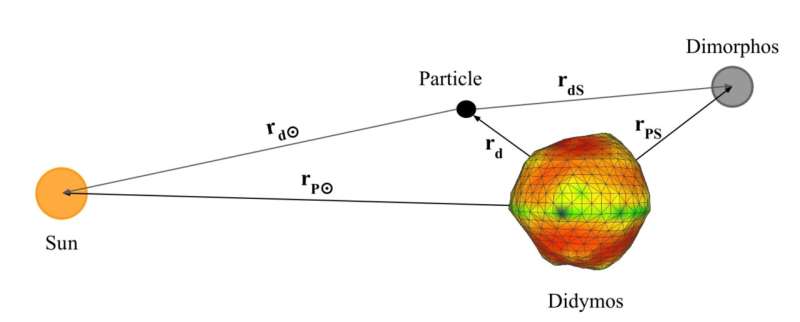March 30, 2023 report
This article has been reviewed according to Science X's editorial process and policies. Editors have highlighted the following attributes while ensuring the content's credibility:
fact-checked
peer-reviewed publication
trusted source
proofread
The asteroid Didymos may be spinning so fast it is flinging off rubble

A team of planetary scientists at Universidad de Alicante, in Spain, has found that the asteroid Didymos may be spinning so fast that it is flinging off rubble from near its equator. In their paper published in the journal Icarus, the group describes their study of the asteroid and explain why its behavior may have an impact on the way that other space objects are studied.
The asteroid Didymos was in the news a lot last year—it is believed to be the parent of Dimorphos, the asteroid's moonlet that was the object of NASA's Double Asteroid Redirection Test—where NASA slammed an object into a space rock to see if doing so could deflect its trajectory. The idea was to find out if doing so could one day save planet Earth from being impacted by a much bigger planetary body. The success of the project suggested the answer is yes, which brought a collective sigh of relief to NASA and other space agencies around the world.
Prior theory has suggested that Dimorphos came to exist due to debris being flung into space from the much larger asteroid Didymos. As bits of material were spun off, they gathered in the vicinity and eventually coalesced to form Dimorphos. Such a theory hints at the possibility that material is still being flung from Didymos. Researchers have been studying its characteristics using data compiled from missions that were tasked with selecting a target for the DART project.
To date, the research team has been able to measure the asteroid's size and its mass and has determined at least some of its composition. They also know that its rotation rate is so fast that it helps to explain the asteroid's top-like shape. The group has fed all that is known about the asteroid into a computer model which showed that it is spinning fast enough to be ejecting material from its mid-section.
If material is being ejected, the researchers believe there are four scenarios that could occur; the material could simply fall back to the asteroid, it could escape into space, get stuck orbiting the asteroid or land on Dimorphos. They believe the first option is the most likely. They will not know for sure, they note, until the European Space Agency's Hera mission gets underway, where a probe will be sent to study both Dimorphos and Didymos and to send back pictures.
More information: Nair Trógolo et al, Lifted particles from the fast spinning primary of the Near-Earth Asteroid (65803) Didymos, Icarus (2023). DOI: 10.1016/j.icarus.2023.115521 . On arXiv: arxiv.org/abs/2303.07333
© 2023 Science X Network





















